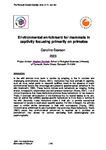Environmental enrichment for mammals in captivity focusing primarily on primates
| dc.contributor.author | Dawson, C. | |
| dc.date.accessioned | 2019-05-13T10:38:42Z | |
| dc.date.available | 2019-05-13T10:38:42Z | |
| dc.date.issued | 2009 | |
| dc.identifier.citation |
Dawson, C. (2009) 'Environmental enrichment for mammals in captivity focusing primarily on primates', The Plymouth Student Scientist, p. 184-194. | en_US |
| dc.identifier.issn | 1754-2383 | |
| dc.identifier.uri | http://hdl.handle.net/10026.1/13861 | |
| dc.description | In the wild animals must learn to survive by adapting to live in complex and challenging environments (Boere, 2001). Institutions that hold animals in captivity, such as zoos, safari parks or research facilities, result in the absence of major environmental factors that encourage and preserve species-typical behaviour in the wild (Markowitz, 1995). These factors include such behaviours as foraging, finding shelter, intraspecific relationships and anti predator behaviour (Boere, 2001). It is of utmost importance that these institutions promote these behaviours for two reasons. Firstly, if eventual reintroduction of the individual into its natural habitat is the aim, then an animal that exhibits species-specific behaviours is more likely to survive in the wild. Secondly, many institutions make it their aim to provide educational resources for people to learn about specific species. For this to happen, the animals need to exhibit similar behaviours to their wild counterparts (Young, 1995). Environmental enrichment is any mechanism that promotes these behaviours. Boere (2001) states that environmental enrichment is required as it provides an environment that allows for optimal well-being both physiologically and psychologically. | en_US |
| dc.language.iso | en | en_US |
| dc.publisher | University of Plymouth | |
| dc.rights | Attribution 3.0 United States | * |
| dc.rights.uri | http://creativecommons.org/licenses/by/3.0/us/ | * |
| dc.subject | wild | en_US |
| dc.subject | animals | en_US |
| dc.subject | wild animals | en_US |
| dc.subject | survive | en_US |
| dc.subject | environment | en_US |
| dc.subject | challenging environments | en_US |
| dc.subject | predator | en_US |
| dc.subject | anti-predator | en_US |
| dc.subject | psychological | en_US |
| dc.subject | zoo | en_US |
| dc.subject | safari park | en_US |
| dc.title | Environmental enrichment for mammals in captivity focusing primarily on primates | en_US |
| dc.type | Article | |
| plymouth.issue | 1 | |
| plymouth.volume | 2 | |
| plymouth.journal | The Plymouth Student Scientist |



